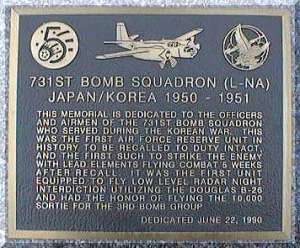731st Memorial Dedication

731st Memorial Dedication ~ 22 June 1990
| After WWII ended in 1945, there were drastic cuts in all branches of the military. Five years later, when hostilities broke out in Korea – actually 40 years ago this month – I don’t believe the average person realized how under strength the military was. In particular, in the Air Force, in low level attack capability. Long gone were the scores of A-20 Havocs, B-25 Mitchells, & B-26 Marauders – either scrapped or replaced with the faster Douglas A-26 Invaders. And of the 48 WWII squadrons equipped with the A-26, only two were left, the 8th and 13th in the 3rd Bomb Group stationed at Johnson AFB Japan. In the early months of the Korean War, these two squadrons bore the brunt of destroying road and rail traffic and providing close air support for ground personnel.All this was not apparent in March of ’51 when I started flying with the 731st. It appeared that this squadron was a regular Air Force Unit that had been active for a number of years with the 3rd Bomb Group. As time passed, I learned that they had been recalled from reserve status less than a year before I joined them. Their history started in 1946 when a group of WWII veterans in the Los Angeles area started holding reserve meetings. Initially they met without pay in classrooms – condemned barracks – wherever. By 1949, two wings had been formed, the 448th and 452nd. Then shortly after the Korean War started, both wings were recalled and combined into the 452nd with 4 squadrons: 728th; 729th; 730th; and 731st. Lead elements of the 731st were flying combat within 5 weeks of recall, but for most aircrews 60 days of intensive flying training had to be completed. Also, ground crews had to be trained, records had to be updated etc… The aircraft used during reserve status was replaced by the A-26, which had been redesigned as the B-26 in 1948. These had to be pulled out of mothballs, renovated at Hill AFB, Utah and then flown to George AFB, California, where the squadron trained. By September, four crews had completed a stepped-up schedule and flew their planes to Japan where they were attached to the 3rd Bomb Group and started flying combat the day after arrival. A short time later, the balance of airplanes, crews and ground support personnel were transported by air and water. With their training focused on RADAR & SHORAN, they became the Night Intruders, the radar and electronic eyes of the Tactical Air Force. This was the only B-26 squadron trained in this fashion. They were pulled out of the 452nd and assigned to the 3rd Bomb Group to bring that group up to strength. The 452nd flew daylight missions from Pusan Korea and the 3rd flew night missions from Iwakuni, Japan. In late June 1951, the 731st was deactivated – ON PAPER – and the 90th which was one of the other WWII squadrons with the 3rd, was reactivated. All the equipment and remaining personnel was then transferred to the 90th. By this time the 731st had flown more than 9000 hours of combat and 2000 missions under every conceivable disadvantages: bad weather, patched-up airplanes; weary personnel and few replacements. They had flown all sorts of missions including high, medium and low-level bombing, visual and radar bombing, front-line support, flare drops, armed reconnaissance, strafing and rocketry… and had the distinction of flying the 10,000 mission for the 3rd Bomb Group. The casualties were: 3 wounded; 2 killed; 5 injured; and 10 missing. The education level: 2.2 years of college per man; highest of any Air Force squadron at the time. |